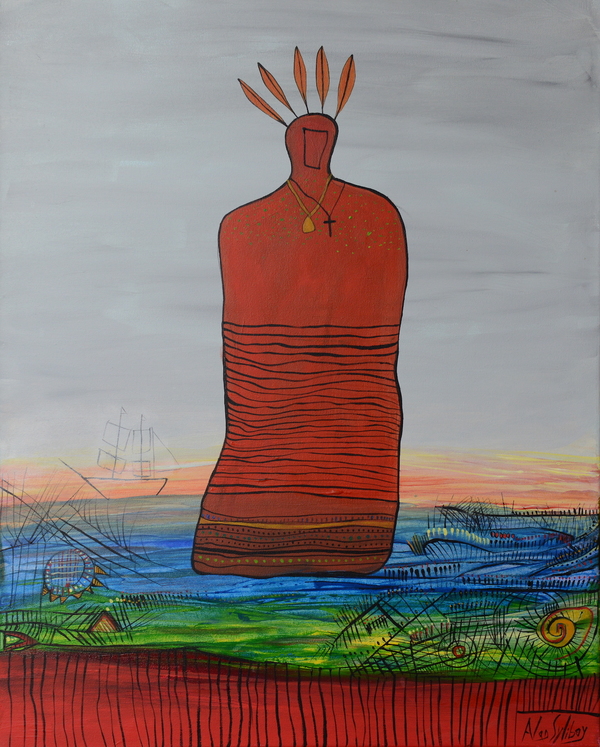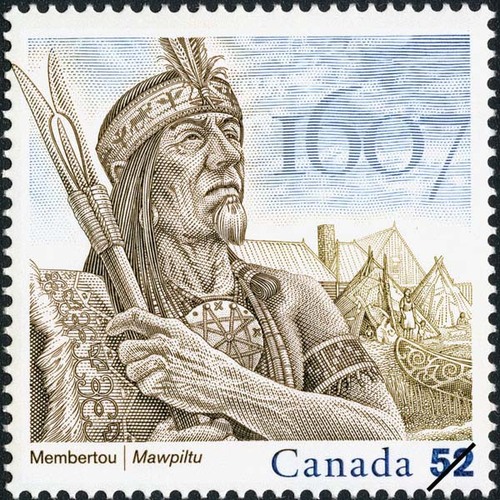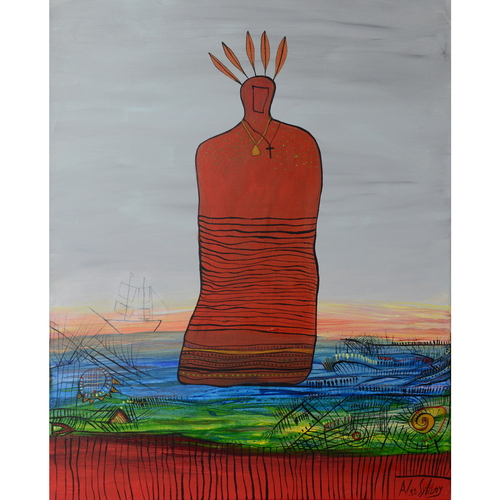
Source: Courtesy of Wikimedia Commons
MEMBERTOU, Henri, chief of a Micmac band, ally of the French; first native baptized in New France; d. 18 Sept. 1611 at Port-Royal (Annapolis Royal, N.S.).
According to Lescarbot, Membertou was already more than 100 years old in 1607. This is probably an exaggeration. The old man stated that at a period when he was himself already married and the father of a family he had known Jacques Cartier. His eldest son Louis is supposed to have been 60 in 1610; and that also appears exaggerated, since all Louis’s children were then very young. The exploits attributed to Henri Membertou during a fighting expedition in 1607 are ill suited to a centenarian. In the same way the pompous titles conferred on Membertou by the French should not be taken literally. He commanded a small following of Micmacs who hunted and fished in the basin of the river and harbour of Port-Royal, and on the shores of St. Mary’s Bay in Nova Scotia. It would be unwise to give to this band a precise figure; that of 100 souls seems a generous estimate. Messire Fléché, who baptized all the Indians passing through Port-Royal, scarcely reached the number of 140 in a year.
The chief of a band, or sagamo, assumed responsibility for directing and protecting a group of individuals and families moving about in a given area. No doubt there was nothing very stable about the composition of a band, since ambitious men frequently set themselves up as sagamos. For payment the chief received presents and a proportion of the yield from hunting and fishing. The young people were under his authority; the married men, partly emancipated, paid him tribute. The sagamo was hardly any richer in consequence, since his income was used up in supporting his attendants and meeting the cost of alliances with his neighbours. Honour, and little else, was his chief reward.
With his position as sagamo Membertou combined that of autmoin or shaman (medicine-man). In return for gifts he made prophecies on the outcome of hunting or war. When called to attend the sick, he would blow upon them to drive out the devil, dance, go into wild contortions, conduct still stranger ceremonies, and make pronouncements on the recovery or approaching death of the patient. The prestige of the autmoin reinforced that of the sagamo and gave him a special authority in the councils. Membertou, inhabiting a remote region of no interest to French fishermen, suddenly found himself in the limelight when Du Gua de Monts came to settle at Port-Royal in 1605. To be the host of the Europeans, within immediate range of their merchandise, was an advantage which all the sagamos envied highly. The jealousy of his fellow-sagamos earned for the old chief the “reputation of being the most evil and treacherous among all those of his nation,” according to Champlain. But this perhaps not impartial judgement is offset by the profound esteem of the French. Father Biard wrote: “This was the greatest, most renowned and. most formidable savage within the memory of man; of splendid physique, taller and larger-limbed than is usual among them; bearded like a Frenchman, although scarcely any of the others have hair upon the chin; grave and reserved; feeling a proper sense of dignity for his position as commander.” He showed an unswerving loyalty towards his European allies. The Port-Royal habitation, when it was left for three years entirely in his hands, did not suffer in any way. His touching friendship with Jean De Biencourt de Poutrincourt was clearly evident in his last address, but also in all his conduct towards this gentleman.
Only one example of his military bravery is known. In 1607 he led an expedition to the River Chouacouët (Saco) to avenge the murder of Panounias, who was both his follower and his son-in-law. After the usual palavers with his allies in a stockaded hut, erected near Port-Royal, the sagamo set out at the head of 400 men, according to Lescarbot, or more likely 30 or 40, as Champlain said. His passage through the Abenaki country, where he had some allies, occasioned a number of skirmishes; Membertou himself approached his enemies under the pretence of friendship and trade, and then treacherously fell upon them. He reported that he had killed 20 men and wounded 10 or 12 others, but he brought back no prisoners; none of his men lost his life. The story of this episode, written by Lescarbot, appears to belong as much to the realm of fancy as to that of history.
The fact that this Micmac sagamo was the first Indian to receive solemn baptism in New France remains his principal claim to distinction. Others before him had been baptized in France, only to return to their pagan customs as soon as they got back. In 1610 Poutrincourt, who was destitute but anxious to get settled in Acadia in order to satisfy Henri IV’s impatience, conceived the plan of raising money in the form of gifts for the Indian neophytes. He landed at Port-Royal with a priest, Jessé Fléché, around 17 June, and tried to seek out the Micmacs, who were scattered for the fishing. He located only the Membertou family of 21 persons, who were baptized ceremoniously on 24 June. The sagamo received the name of the king, Henri; his wife was called Marie, like the queen; his eldest son was given the name of the dauphin, Louis, who by this date had already become Louis XIII. These baptisms, for which there had been no preparation, changed nothing in the behaviour of the neophytes, who preserved their pagan habits, to the scandal of the Jesuits.
Henri Membertou was as ignorant as the others; he did however show exceptional aptitude. He completely renounced the profession of shaman, and took on Christian responsibilities to the extent that he could understand them. When his son Actodin fell ill and all were preparing to subject him to the tribe’s traditional rites, Membertou listened without impatience to Father Biard’s reprimands and followed his instructions. He urged the missionaries to learn the Micmac tongue, for he earnestly desired to be catechized and thereafter admitted into their apostolate. His steadfast refusal to practise polygamy, a custom of the sagamos, was greatly admired. At the end of August 1611 Membertou, a victim of dysentery, came to Port-Royal, where Father Massé received him into his hut during Father Biard’s absence. The latter, when he returned on 8 September, shared with his companion the nursing of the ailing man. But when the old man’s wife and daughter arrived, he had to be removed from the habitation, because Charles de Biencourt refused to admit him into another part of it. On 16 September Membertou made his farewell speech, after having confessed his sins. He announced his wish to be buried with his pagan ancestors. Father Biard opposed this, whereas Biencourt, acting as an interpreter, agreed with the sick man. The Jesuit withdrew in order to make his disapproval clear, but returned to give extreme unction to the dying Indian. Two days later Membertou changed his mind and asked to be buried with the French. He died Sunday, 18 September, after vespers, and on the Monday he was given a solemn funeral.
All the sources concerning Membertou may be found in the following: Champlain, Works (Biggar); Œuvres (Laverdière), 234 et passim. Factum (1614), 15–17. JR (Thwaites), I–IV, passim. Lescarbot, History (Grant).
Cite This Article
Lucien Campeau, “MEMBERTOU (baptized Henri),” in Dictionary of Canadian Biography, vol. 1, University of Toronto/Université Laval, 2003–, accessed April 5, 2025, https://www.biographi.ca/en/bio/membertou_1E.html.
The citation above shows the format for footnotes and endnotes according to the Chicago manual of style (16th edition). Information to be used in other citation formats:
| Permalink: | https://www.biographi.ca/en/bio/membertou_1E.html |
| Author of Article: | Lucien Campeau |
| Title of Article: | MEMBERTOU (baptized Henri) |
| Publication Name: | Dictionary of Canadian Biography, vol. 1 |
| Publisher: | University of Toronto/Université Laval |
| Year of publication: | 1966 |
| Year of revision: | 1979 |
| Access Date: | April 5, 2025 |




